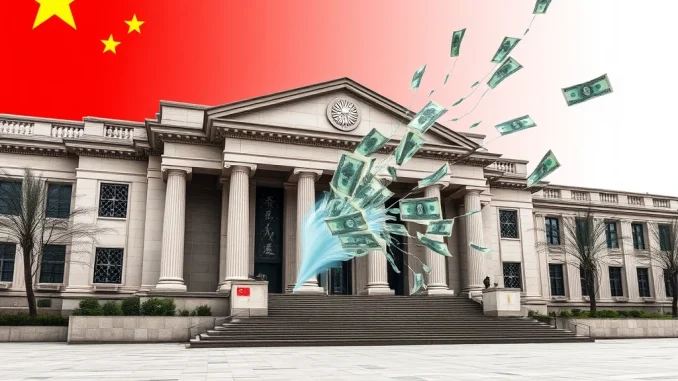
Big news from Beijing! The People’s Bank of China (PBOC), the nation’s central bank, just announced a significant move that could ripple through global markets. PBOC Governor Pan Gongsheng confirmed today, May 7th, that the PBOC will cut the reserve requirement ratio (RRR) for financial institutions by 0.5%. This decision, reported by state media like People’s Financial News, is a key piece of China monetary policy aimed at influencing the economy. For those keeping an eye on global liquidity and economic signals that can indirectly impact asset classes like cryptocurrencies, this is a development worth understanding.
What is the Reserve Requirement Ratio (RRR) and Why Does the PBOC Cut It?
Think of the reserve requirement ratio as the amount of cash that banks must keep on hand, mandated by the central bank. It’s money they can’t lend out. When a central bank like the PBOC cuts the RRR, it effectively frees up some of that locked-up capital, allowing financial institutions to lend more money. This action is a common tool in the China central bank’s toolkit to inject liquidity into the banking system and economy.
- Increased Lending Capacity: Banks have more funds available to offer loans to businesses and individuals.
- Lower Borrowing Costs: More liquidity can lead to lower interest rates on loans, making it cheaper for companies and consumers to borrow.
- Stimulate Economic Activity: The goal is to encourage investment, spending, and overall economic growth.
- Support Specific Sectors: Sometimes RRR cuts are targeted or intended to benefit particular parts of the economy needing a boost.
How Does This PBOC RRR Cut Impact Financial Institutions?
For financial institutions in China, a 0.5% RRR cut is a direct benefit. It means they have more funds available for lending and investment activities. This can potentially improve their profitability and operational flexibility. It signals the central bank’s support for the financial system and the broader economy.
The cut applies across the board, providing a systemic liquidity boost. This makes it easier for banks to meet loan demand and manage their balance sheets, potentially reducing funding costs.
Could This China Monetary Policy Affect Global Markets and Crypto?
While this is a domestic Chinese policy, its effects can extend globally. China is a major player in the world economy. Actions by the China central bank to stimulate growth can:
- Influence global demand for goods and services.
- Impact currency exchange rates (like the Yuan).
- Affect global capital flows as investors react to changes in China’s economic outlook and liquidity.
For cryptocurrency markets, the connection is less direct but still relevant. Increased liquidity in major economies, including China, can sometimes correlate with increased investor appetite for riskier assets. While specific capital controls in China limit direct crypto investment from mainland banks, the broader signal of economic stimulus and potential for increased global liquidity is something market participants watch. It’s another piece of the complex puzzle that influences market sentiment and capital allocation decisions worldwide.
What Are the Potential Challenges or Downsides?
While the intent is stimulus, RRR cuts aren’t without potential drawbacks:
- Effectiveness: Will the freed-up funds actually translate into increased productive lending and economic growth, or will they remain within the financial system?
- Inflation Risk: Injecting liquidity can, in some scenarios, contribute to inflationary pressures, although China’s current economic situation might make this less of an immediate concern.
- Market Reaction: Markets might interpret the move differently – as a sign of proactive support or as a signal that the economy needs significant help.
Monitoring how financial institutions utilize the extra liquidity and the subsequent impact on lending rates and economic data will be key.
Key Takeaways on the Reserve Requirement Ratio Cut
The PBOC’s decision to cut the reserve requirement ratio by 0.5% is a clear signal of its intent to support the Chinese economy through monetary easing. This move directly impacts financial institutions by increasing their lending capacity and is expected to lower borrowing costs and stimulate economic activity. While primarily a domestic policy, it adds to the global picture of central bank actions and liquidity, which is always relevant for participants in global markets, including those in the cryptocurrency space, as they assess overall risk appetite and economic trends.



